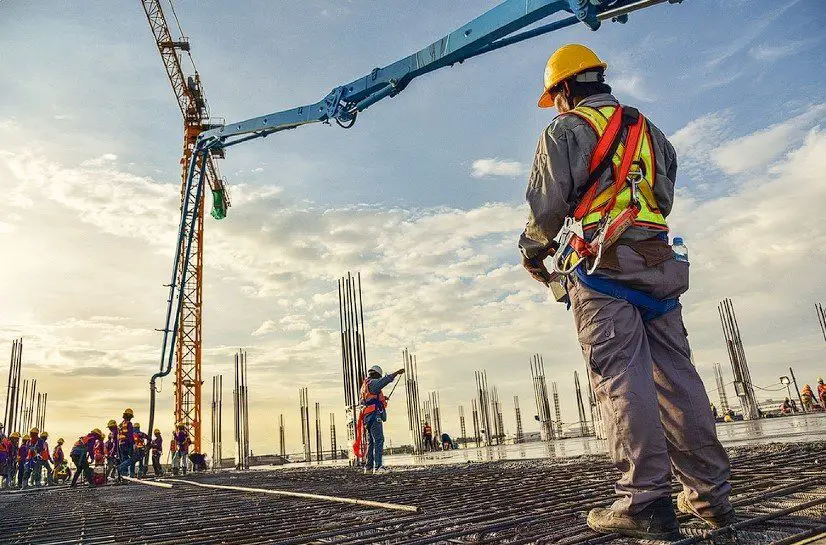Concrete Pouring Work Method Statement
This method statement specifies the procedures and methods to be employed for placing, pouring, curing, and repairing concrete works and blinding concrete.
Before placing any concrete or pouring any concrete, all quality checks must be accomplished, and the “approval to concrete” instruction provided by the client/consultant.
Table of Contents
When the concrete arrives on site, it will be placed in one of three ways:
- Direct discharge (or chute discharge)
- Crane with a bucket
- Concrete Pump
The method to be utilized will be determined by the site conditions and the volume of the pour. The concrete shall be placed in line with the specification for concrete cast in place, the essential points of which are as follows:
Method Of Concrete Placement | Concrete Pouring
Concrete should be placed as near to its final position as possible and should not be shifted laterally by vibration. Concrete should not be over-vibrated.
Concrete should not be dropped from a height greater than 2 meters.

“Cold joints” lasting more than 40 minutes must be avoided. Concrete must be placed within one hour after the addition of the mixing water. Concrete pumping is only permitted with consultant approval.
If rain is forecasted while concreting, there should be enough plastic/canvas sheets on hand to cover the entire casting area. A water pump must be in place and ready to go if seepage water is entering the excavation in large quantities or if rain is forecast.
Concrete Curing Method
The exposed concrete surface shall be covered with soaked hessian sacks after the initial set of the concrete and when the concrete is hard enough not to be damaged by such an action. For seven days, these sacks must be left in place and maintained in a saturated condition.
After the formwork has been removed, the formed surfaces must be cured as described above, or a curing compound must be applied (refer to 2.5 above).
Once the concrete has hardened, laitance can be removed with gentle chipping and wire brushing.
Mechanical chipping shall be used to prepare construction joints, taking care not to dislodge the coarse aggregates. This must be done at least 24 hours after the placing of the concrete surface, or a concrete surface retarder may be utilized.
Concrete Inspection and Repair Work
After the formwork is removed, the element must be verified for level, dimensions, and surface flaws; any nonconformity must be brought to the notice of the consultant/inspector before it may be rectified.
The action to be taken to correct any nonconformity will be proposed by the primary contractor and approved by the consultant.
Before using any patching, grouting, or other such compound for rectification works, it must be submitted to and approved by the consultant.
Curing compounds must be approved and of the transparent kind if utilized.
Construction Joints
Construction joints must be placed at the positions indicated on the plans or as submitted in a proposal, and must always be at right angles to the axis of the structural member.
All columns and walls must have kickers installed at the base.
Blinding Concrete | Lean Concrete Work
The following equipment is used in blinding works:
- Air Compressor
- Hand tools, such as a handsaw, a wire cutter, a brush, and measuring tapes
- Wooden float Shovel Concrete Pump
Concrete Blinding | Lean Concrete Procedure
All relevant papers, such as shop drawings, method statements, material approvals, subcontractor approvals, test certificates, and so on, must be available on-site.
Establish the ready mix and concrete grade supply sources.
The substrate’s compaction/plate load test must be approved and available.
Prior to the installation of any blinding, one layer of a 1000-gauge polythene sheet must be installed.
All concrete-encased duct installations must be approved by the Engineer.
Before beginning the concrete blinding works, make sure MEP permission is received.
Polythene sheets, hessian cloths, and sweet water arrangements must be prepared for curing.
Formworks
All materials used for form works must be clean, solid, and deflection-free.
Install formworks to the correct dimensions and ensure that alignment and form-work levels are within tolerances.
To maintain the forms’ perfect alignment, the shutters will be supported by steel bars on all sides.
For concrete level maintenance, level guides must be installed.
Concrete Placement Blinding
The blinding concrete for the structures and ditches will be placed with the help of a pump. The concrete grade will be determined by the approved concrete design mix.
Place the concrete no higher than 1.5 meters.
Following the completion of the casting, a sufficient number of personnel must be available for finishing works, cleaning, and safeguarding of the casted concrete.
Concrete Curing
Concrete must be cured using sweet water, as directed by the client/consultant. To maintain this, the entire surface of the foundations will be covered with a damp sack cloth.
tag: Method Statement for Concrete Pouring Work

